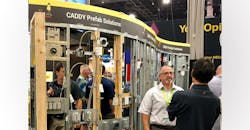IoT is everywhere. Not all that many years ago, it seemed like the Internet of Things (IoT) was a technology looking for an application. Now app-based control of virtually any electrical or electronic device with an IP (Internet Protocol) device is everywhere. It’s particularly common in the lighting controls market. Electrical manufacturers have also harnessed IoT for applications using sensors that monitor workspaces, public spaces and dozens of indoor and outdoor applications where end users want to pull down data from the cloud on security, energy efficiency, environmental concerns and building automation applications. As Jim Phelan, national sales manager, Building IoT Solutions at Siemens, said in his NECA Show presentation, “Exceeding Customer Expectations with Smart Building IoT Solutions,” “With a mobile interface, data and insights are available anytime, anywhere.”
Work smart. Times are good in the electrical construction market right now, and many companies can’t find enough qualified workers to staff all the jobs they could get. But in an always cyclical industry, electrical contractors must be ready for the darker days when work isn’t as plentiful. Now is the time to be operating efficiently and to eliminate bad operational habits. Anton Mikec, Lighthouse Electric, Canonsburg, PA, said in his NECA workshop, “Grow Your Business by Knowing Your Core Markets, “In today’s market we have to be cautious. It’s easy to get sloppy. When times are good, tighten up operations so you are ready for when it slows down.”
Prefab products are everywhere. It was tough to count how many different companies were showcasing prefab products at NECA. Some of the prefabricated products that caught our eye were at the ABB, Arlington Industries, Caddy/NVent, Garvin Industries/Southwire, Legrand and Orbit Industries booths. Colin Ross with ABB’s e-Fab group gave an interesting presentation on prefab on Sunday, Sept. 15, which we covered in a previous NECA Show report.
Unique LED lighting systems. If these lighting systems catch on, they could revolutionize how electrical contractors install lighting. LEDs don’t need much power to operate and 18V wiring (often called “bell wire”) is super simple to install and terminate. ATX LED, Austin, TX, a first-time NECA exhibitor, had an intriguing display in its booth for its 18V LED system for residential applications.
Murray Freeman, the company’s CEO and founder, said in a NECA Techtopia session that ATX LED has installed their system in more than in dozen houses in Austin, with each residence having 60 or more LED fixtures. The LEDs can be wired in series, and a single driver can be located remotely and drive a group of fixtures, instead of having a driver in each LED lamp, as is the case with replacement LED lamps. This eliminates heat in the fixture, which has been shown to cause premature failure of some retrofit LED lamps. Another advantage is the cost savings in using 18V wire instead of 14 AWG wire.
About the Author
Jim Lucy
Editor-in-Chief, Electrical Wholesaling & Electrical Marketing
Over the past 40-plus years, hundreds of Jim’s articles have been published in Electrical Wholesaling, Electrical Marketing newsletter and Electrical Construction & Maintenance magazine on topics such as electric vehicles, solar and wind development, energy-efficient lighting and local market economics. In addition to his published work, Jim regularly gives presentations on these topics to C-suite executives, industry groups and investment analysts.
He launched a new subscription-based data product for Electrical Marketing that offers electrical sales potential estimates and related market data for more than 300 metropolitan areas. In 1999, he published his first book, “The Electrical Marketer’s Survival Guide” for electrical industry executives looking for an overview of key market trends.
While managing Electrical Wholesaling’s editorial operations, Jim and the publication’s staff won several Jesse H. Neal awards for editorial excellence, the highest honor in the business press, and numerous national and regional awards from the American Society of Business Press Editors. He has a master’s degree in communications and a bachelor’s degree in journalism from Glassboro State College, Glassboro, N.J. (now Rowan University) and studied electrical design at New York University and graphic design at the School for Visual Arts.

